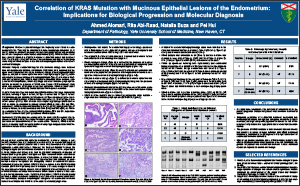Correlation of KRAS Mutation with Mucinous Epithelial Lesions of the Endometrium: Implications for Biological Progression and Molecular Diagnosis
Ahmed Alomari, Rita Abi-Raad, Natalia Buza and Pei Hui
Department of Pathology, Yale School of Medicine, New Haven, CT, USA
ABSTRACT
Background: Mucinous epithelial changes are frequently encountered in endo-metrial biopsies. They may be classified into three morphologic categories (A, B and C) based on architectural complexity and cytological atypia to help predicting the risk of subsequent endometrial adenocarcinoma (EAC). KRAS mutations have been recently reported in atypical mucinous endometrial lesions and mucinous EAC. The aim of our study was to assess the prevalence and diagnostic and prog-nostic utility of KRAS mutation in the different morphological classes of mucinous endometrial changes.
Methods: Forty-six endometrial biopsies with mucinous change were retrieved from our departmental archives. All available H&E slides were reviewed and the cases were categorized into simple mucinous change without cytological atypia (Type A), complex mucinous epithelium without cytological atypia (Type B), mark-edly complex mucinous changes with cytological atypia (Type C) or mucinous EAC. DNA was extracted from formalin fixed paraffin embedded tissue sections, sub-jected to PCR amplification, followed by single strand conformation polymorphism analysis to identify the presence of KRAS exon 2 codon12/13 mutation(s). Only cases with complete histological review and informative KRAS mutation status were included in the final study. Clinical data and follow-up were recorded.
Results: Forty-four cases with informative KRAS mutation status were successfully analyzed, including 4 Type A lesions, 22 Type B lesions and 11 Type C lesions. Clinical follow-up was available for 35 patients. All Type A mucinous lesions were negative for KRAS mutation. KRAS mutation was present in 13 of 22 Type B mu-cinous lesions (59.1%), 50% of which had complex atypical hyperplasia and no EAC on follow up compared to patients without KRAS mutation (0% and 33%, respectively). KRAS mutation was identified in 5 of 11 (45.5%) patients with Type C mucinous lesions, and was associated with CAH (75%) and EAC (25%) on follow-up, compared to Type C cases without KRAS mutation (50% and 0%, respectively). Six of 7 mucinous EAC (85.7%) harbored KRAS mutation.
Conclusion: Corroborating the existing data, the current study confirms high incidence of KRAS mutation in complex mucinous epithelial lesions (Type B and C) and mucinous adenocarcinoma of the endometrium. Therefore, KRAS mutation may be a clinically useful molecular marker of early stage malignant transformation of mucinous lesions of the endometrium.
©2013 Yale Department of Pathology. All rights reserved.
Any redistribution or reproduction of part or all of the contents in any form is prohibited. You may not, except with express written permission of the author or the Department of Pathology, distribute or commercially exploit the content, nor may you transmit it or store it in any other website or other form of electronic retrieval system, including use for educational purposes.
